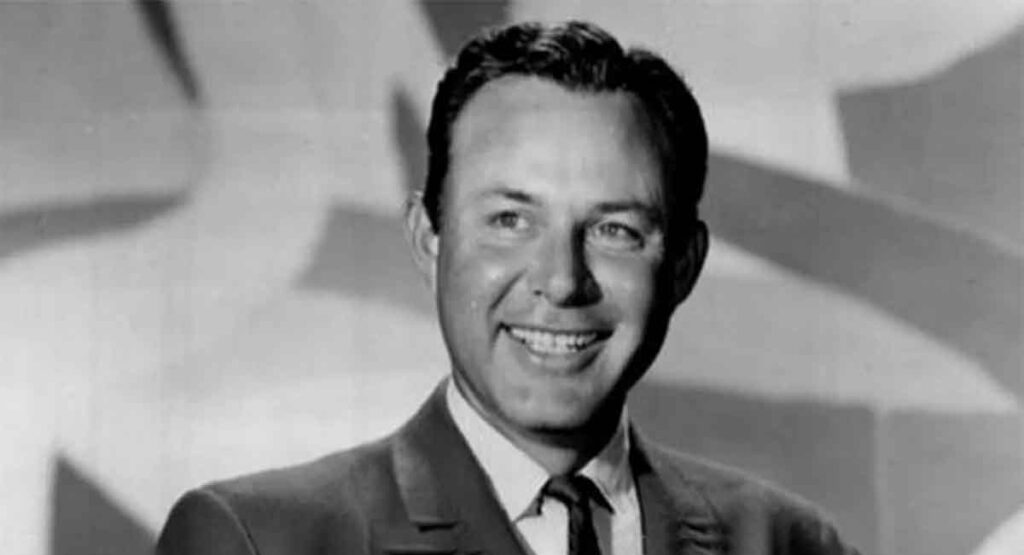Jim Reeves was a singer whose voice could melt the coldest of hearts, and his style bridged the worlds of country and pop in a way few had done before. Born in 1923, he grew up in Texas dreaming of making music that would reach radio waves far beyond his hometown.
His smooth, easygoing vocals quickly earned him the nickname “Gentleman Jim.” By the early 1960s, he was one of the biggest stars in country music, attracting fans all around the globe with hits like “Welcome to My World” and “I Love You Because.”
However, his iconic track “He’ll Have to Go” is the song that truly skyrocketed him to legendary status. Released in 1959, it was originally hidden away as the B-side of another tune called “In a Mansion Stands My Love,” but when DJs started playing it instead, a star was born.
“He’ll Have to Go” tells a story about a simple phone call between two lovers. The main character realizes there’s another guy right there with his sweetheart, so he urges her to kindly tell that other fellow to get lost—he’ll have to go!
The single soared on both the country and pop charts, helped by Reeves’ gentle yet commanding voice. His rich, velvety style was perfect for radio, making people fall in love with the Nashville Sound he helped to popularize.
Behind the scenes, “He’ll Have to Go” was recorded with a simple band: Floyd Cramer on piano, Marvin Hughes on vibraphone, Bob Moore on bass, Buddy Harman on drums, Hank Garland on guitar, plus the Anita Kerr Singers on backup vocals. This combination gave the track a polished, pop-friendly feel that appealed to fans of both country twang and mainstream melodies alike.

At the heart of Jim’s success was his ability to blend the best of country storytelling with the easy-listening charm of pop. This approach eventually influenced loads of other artists who wanted to cross musical boundaries, much like we see today in pop-country acts ranging from Florida Georgia Line to Jelly Roll.
Tragically, Jim Reeves’ bright future came to a sudden end on July 31, 1964, when he and his manager-pianist Dean Manuel were flying back to Nashville. Piloting his single-engine Beechcraft Debonair, Reeves got caught in a thunderstorm that caused radio towers to lose contact with the plane.
For almost two days, more than 2,000 volunteers and local musicians like Chet Atkins, Marty Robbins, Ernest Tubb, Eddy Arnold, and others searched tirelessly. They combed through miles of rugged Tennessee terrain, hoping to find Reeves and Manuel alive.
On August 2, the plane’s wreckage was finally discovered in a wooded area near Brentwood, just east of Franklin Road. Reeves, who was only 39 years old, and Manuel died in the crash, sending waves of shock throughout Nashville and beyond.
The news spread rapidly, and fans by the hundreds gathered near the crash site, causing local traffic jams. The loss was felt especially hard at the Grand Ole Opry, where Reeves was a beloved member who had just finished recording “I’m a Hit Again” days before the accident.
At the time, Jim Reeves was at the very top of his game, an international star with a devoted following. Many writers and music historians say the suddenness of his death was like losing one of today’s biggest stars in the blink of an eye.
Even though his life was cut short, Jim Reeves’ impact on country music remains powerful. His widow, Mary Reeves, carried on his legacy, while fans across the globe continued to cherish that signature voice.
“He’ll Have to Go” still resonates with listeners who appreciate its heartfelt longing and smooth delivery, which many call the “velvet touch.” Its chart performance was stunning, shooting to No. 1 on the Hot Country Singles chart for 14 weeks and reaching No. 2 on the Billboard Hot 100.
Other performers, from Elvis Presley to Tom Jones, have covered “He’ll Have to Go.” There was even a playful “answer song” called “He’ll Have to Stay,” making it clear that Jim Reeves’ influence extended beyond just one recording.
His style opened doors for country-pop crossovers, helping future generations of artists experiment with more polished, radio-friendly production. Although times and tastes have changed, Jim’s approach is still felt in how modern musicians blend musical genres.
Today, more than 60 years after that fateful plane crash, people still talk about Reeves’ warm, inviting sound and gentle persona. Tourists visiting Nashville often hear about Gentleman Jim’s story, reminding them that the city’s musical history is filled with both triumph and tragedy.
“He’ll Have to Go” stands as a milestone that helped shape country music’s future, proving just how far a good melody and an unforgettable voice can go. It captures the magical spark of Reeves at his finest, combining classic country storytelling with a smooth, timeless elegance.

Jim Reeves’ tragic death reminds us that life can be unpredictable, even for someone at the top of their career. Yet while he may be gone, his music remains very much alive, resonating with anyone who’s ever loved a classic ballad with a dash of countryside soul.
His legacy endures through playlists, tribute artists, and the countless covers of his songs that pop up whenever someone wants a taste of that legendary Reeves charm. In a way, every time we hear “He’ll Have to Go,” we’re reminded of Jim’s ability to speak a thousand words through a single line.
Whether it’s the haunting beginnings of “Put your sweet lips a little closer to the phone” or the gentle request that the other man in the room must kindly leave, the warm nostalgia of the tune still melts hearts. For teenage fans discovering him today, there’s something special about that easygoing style, one that proves great music can outlast any storm.
Yes, it’s heartbreaking that Jim Reeves died so young, but we can celebrate the music he left behind. “He’ll Have to Go” is more than just a country-pop single; it’s Jim Reeves’ lasting gift to listeners everywhere, echoing his sweet voice and guiding spirit for generations to come.
You can listen to the song here:




